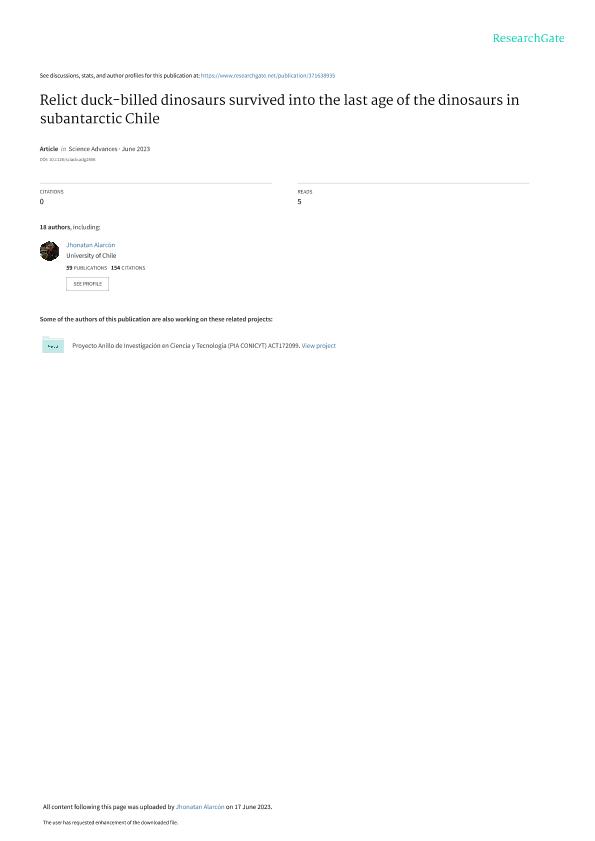Artículo
Relict duck-billed dinosaurs survived into the last age of the dinosaurs in subantarctic Chile
Alarcón Muñoz, Jhonatan Andrés; Vargas, Alexander O.; Püschel, Hans P.; Soto-Acuña, Sergio; Manríquez, Leslie; Leppe, Marcelo; Kaluza, Jonatan Ezequiel ; Milla, Verónica; Gutstein, Carolina Simon; Palma-Liberona, José; Stinnesbeck, Wolfgang; Frey, Eberhard; Pino, Juan Pablo; Bajor, Dániel; Núñez, Elaine; Ortiz, Héctor; Rubilar Rogers, David; Cruzado Caballero, Penélope
; Milla, Verónica; Gutstein, Carolina Simon; Palma-Liberona, José; Stinnesbeck, Wolfgang; Frey, Eberhard; Pino, Juan Pablo; Bajor, Dániel; Núñez, Elaine; Ortiz, Héctor; Rubilar Rogers, David; Cruzado Caballero, Penélope
 ; Milla, Verónica; Gutstein, Carolina Simon; Palma-Liberona, José; Stinnesbeck, Wolfgang; Frey, Eberhard; Pino, Juan Pablo; Bajor, Dániel; Núñez, Elaine; Ortiz, Héctor; Rubilar Rogers, David; Cruzado Caballero, Penélope
; Milla, Verónica; Gutstein, Carolina Simon; Palma-Liberona, José; Stinnesbeck, Wolfgang; Frey, Eberhard; Pino, Juan Pablo; Bajor, Dániel; Núñez, Elaine; Ortiz, Héctor; Rubilar Rogers, David; Cruzado Caballero, Penélope
Fecha de publicación:
06/2023
Editorial:
Science Advances is the American Association for the Advancement of Science
Revista:
Science Advances
ISSN:
2375-2548
Idioma:
Inglés
Tipo de recurso:
Artículo publicado
Clasificación temática:
Resumen
In the dusk of the Mesozoic, advanced duck-billed dinosaurs (Hadrosauridae) were so successful that they likely outcompeted other herbivores, contributing to declines in dinosaur diversity. From Laurasia, hadrosaurids dispersed widely, colonizing Africa, South America, and, allegedly, Antarctica. Here,we present the first species of a duck-billed dinosaur from a subantarctic region, Gonkoken nanoi, of early Maastrichtian age in Magallanes, Chile. Unlike duckbills further north in Patagonia, Gonkoken descends from North American forms diverging shortly before the origin of Hadrosauridae. However, at the time, non-hadrosaurids in North America had become replaced by hadrosaurids. We propose that the ancestors of Gonkoken arrived earlier in South America and reached further south, into regions where hadrosaurids never arrived: All alleged subantarctic and Antarctic remains of hadrosaurids could belong to non-hadrosaurid duckbills like Gonkoken. Dinosaur faunas of the world underwent qualitatively different changes before the Cretaceous-Paleogene asteroid impact, which should be considered when discussing their possible vulnerability.
Palabras clave:
Gondwana
,
paleontology
,
Hadrosauroidea
,
subantarctic
Archivos asociados
Licencia
Identificadores
Colecciones
Articulos(SEDE CENTRAL)
Articulos de SEDE CENTRAL
Articulos de SEDE CENTRAL
Citación
Alarcón Muñoz, Jhonatan Andrés; Vargas, Alexander O.; Püschel, Hans P.; Soto-Acuña, Sergio; Manríquez, Leslie; et al.; Relict duck-billed dinosaurs survived into the last age of the dinosaurs in subantarctic Chile; Science Advances is the American Association for the Advancement of Science; Science Advances; 9; 24; 6-2023; 1-19
Compartir
Altmétricas



